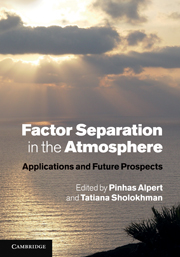Book contents
- Frontmatter
- Contents
- List of contributors
- Foreword
- Preface
- 1 Introduction
- 2 The Factor Separation Methodology and the fractional approach
- 3 Investigation of the Factor Separation features for basic mathematical functions
- 4 Factor Separation Methodology and paleoclimates
- 5 Meso-meteorology: Factor Separation examples in atmospheric meso-scale motions
- 6 Using the Alpert–Stein Factor Separation Methodology for land-use land-cover change impacts on weather and climate process with the Regional Atmospheric Modeling System
- 7 Application of Factor Separation to heavy rainfall and cyclogenesis: Mediterranean examples
- 8 Experience in applying the Alpert–Stein Factor Separation Methodology to assessing urban land-use and aerosol impacts on precipitation
- 9 Free and forced thermocline oscillations in Lake Tanganyika
- 10 Application of the Factor Separation Methodology to quantify the effect of waste heat, vapor and pollution on cumulus convection
- 11 The use of the Alpert–Stein Factor Separation Methodology for climate variable interaction studies in hydrological land surface models and crop yield models
- 12 Linear model for the sea breeze
- 13 Experience and conclusions from the Alpert–Stein Factor Separation Methodology
- 14 Tagging systematic errors arising from different components of dynamics and physics in forecast models
- 15 Some difficulties and prospects
- 16 Summary
- Appendix: References employing the Alpert–Stein Factor Separation Methodology
- References
- Index
4 - Factor Separation Methodology and paleoclimates
Published online by Cambridge University Press: 03 May 2011
- Frontmatter
- Contents
- List of contributors
- Foreword
- Preface
- 1 Introduction
- 2 The Factor Separation Methodology and the fractional approach
- 3 Investigation of the Factor Separation features for basic mathematical functions
- 4 Factor Separation Methodology and paleoclimates
- 5 Meso-meteorology: Factor Separation examples in atmospheric meso-scale motions
- 6 Using the Alpert–Stein Factor Separation Methodology for land-use land-cover change impacts on weather and climate process with the Regional Atmospheric Modeling System
- 7 Application of Factor Separation to heavy rainfall and cyclogenesis: Mediterranean examples
- 8 Experience in applying the Alpert–Stein Factor Separation Methodology to assessing urban land-use and aerosol impacts on precipitation
- 9 Free and forced thermocline oscillations in Lake Tanganyika
- 10 Application of the Factor Separation Methodology to quantify the effect of waste heat, vapor and pollution on cumulus convection
- 11 The use of the Alpert–Stein Factor Separation Methodology for climate variable interaction studies in hydrological land surface models and crop yield models
- 12 Linear model for the sea breeze
- 13 Experience and conclusions from the Alpert–Stein Factor Separation Methodology
- 14 Tagging systematic errors arising from different components of dynamics and physics in forecast models
- 15 Some difficulties and prospects
- 16 Summary
- Appendix: References employing the Alpert–Stein Factor Separation Methodology
- References
- Index
Summary
The relative contribution of the individual forcings, the feedbacks and the synergisms can be quantified by using different techniques, such as the Alpert–Stein Factor Separation Methodology (here abbreviated FS; Stein and Alpert, 1993) or other feedback analyses. In an attempt to better understand the role of the temperature–albedo feedback of the greenhouse gases (water vapour and CO2), and of the insolation at the Last Glacial Maximum (LGM), several sensitivity experiments have been made with a radiative convective model (Berger et al., 1993) and results discussed using both the classical feedback analysis and FS methodology. The LGM cooling is simulated to be 4.5 °C, of which 3°C is in response to the insolation–albedo forcing and 1.5 °C is from the CO2 forcing. In these experiments, the water vapour feedback (WVF) is included, but the synergisms appear to be very small. The direct influence of the insolation–albedo forcing is a cooling of 1.8 °C, on top of which the WVF adds 1.2 °C.The remaining 1.5 °C is due to the CO2 forcing, of which 0.9 °C comes from its direct influence and 0.6 °C is due to the WVF feedback.
The FS methodology and a generalisation of the classical linear feedback analysis technique are also used to identify the individual contributions of climatic factors and of their synergism to the Holocene climate change signal.
- Type
- Chapter
- Information
- Factor Separation in the AtmosphereApplications and Future Prospects, pp. 28 - 52Publisher: Cambridge University PressPrint publication year: 2011
- 1
- Cited by



